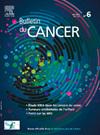Prophylaxie chirurgicale mammaire chez les patientes à très haut risque de cancer du sein
IF 1.1
4区 医学
Q4 ONCOLOGY
引用次数: 0
Abstract
Introduction
Le cancer du sein associé à des variants pathogènes des gènes BRCA1 et BRCA2 nécessite une prise en charge spécifique. Cette synthèse examine les bénéfices pronostiques, les stratégies chirurgicales prophylactiques et les impacts sur la qualité de vie des patientes présentant un risque très élevé de cancer du sein. La prophylaxie mammaire s’adresse aux femmes à haut risque de cancer du sein : un risque évalué à partir de leurs antécédents personnels et familiaux ou par un diagnostic de variants pathogènes sur des gènes à risque. Une prise en charge personnalisée repose sur une surveillance clinique et radiologique renforcée, l’utilisation d’outils prédictifs tels que BOADICEA, et des options chirurgicales comme la mastectomie bilatérale prophylactique, qui permet de réduire le risque de cancer de plus de 90 %. Bien que son impact sur la survie globale soit encore débattu, les progrès des techniques chirurgicales ont significativement amélioré les résultats esthétiques et la satisfaction des patientes grâce à des méthodes modernes de reconstruction. La stratégie chirurgicale, qu’elle soit primaire ou secondaire, doit être individualisée en tenant compte des antécédents, des besoins thérapeutiques et des préférences des patientes. La mastectomie avec conservation de l’enveloppe cutanée, souvent réalisée en une ou deux étapes, offre des bénéfices psychosociaux significatifs, bien que la radiothérapie puisse augmenter le risque de complications. Les options incluent la reconstruction immédiate, par implant ou par technique autologue, adaptées à la morphologie de la patiente et aux éventuels traitements adjuvants.
Conclusion
La mastectomie bilatérale prophylactique constitue une stratégie efficace pour réduire le risque de cancer du sein, en particulier chez les patientes porteuses de variants pathogènes des gènes BRCA. Une évaluation personnalisée, une information détaillée sur les risques et les impacts, ainsi que l’utilisation d’outils d’aide à la décision sont essentiels pour permettre des choix éclairés et adaptés aux besoins individuels des patientes.
Introduction
Breast cancer associated with pathogenic variants of BRCA1 and BRCA2 genes requires specific management. This review examines the prognostic benefits, prophylactic surgical strategies, and impact on quality of life of patients at very high risk of breast cancer. Breast surgical prophylaxis concerns women at high risk of breast cancer with a risk assessment based on their personal and family history, or by diagnosis of pathogenic variants in high-risk genes. Personalized management is based on enhanced clinical and radiological monitoring, the use of predictive tools such as BOADICEA, and surgical options such as prophylactic bilateral mastectomy, which can reduce the risk of cancer by over 90 %. Although its impact on overall survival is still debated, advances in surgical techniques have significantly improved aesthetic results and patient satisfaction, thanks to modern reconstruction methods. The surgical strategy, whether primary or secondary, must be individualized, considering the patient's history, therapeutic needs, and preferences. Mastectomy with preservation of the skin envelope, often performed in one or two stages, offers significant psychosocial benefits, although radiotherapy may increase the risk of complications. Options include immediate reconstruction, by implant or autologous technique, adapted to the patient's morphology and any adjuvant treatments.
Conclusion
Prophylactic bilateral mastectomy is an effective strategy for reducing the risk of breast cancer, particularly in patients with pathogenic BRCA gene variants. Personalized assessment, detailed information on risks and impacts, and the use of decision-support tools are essential to enable informed choices tailored to individual patient needs.
求助全文
约1分钟内获得全文
求助全文
来源期刊

Bulletin Du Cancer
医学-肿瘤学
CiteScore
1.90
自引率
16.70%
发文量
224
审稿时长
37 days
期刊介绍:
Without doubt, the ''Bulletin du Cancer'' is the French language publication of reference in the field of cancerology. Official organ of the French Society of Cancer, this journal covers all the information available, whether in the form of original articles or review articles, but also clinical cases and letters to the editor, including various disciplines as onco-hematology, solids tumors, medical oncology, pharmacology, epidemiology, biology as well as fundamental research in cancerology. The journal proposes a clinical and therapeutic approach of high scientific standard and regular updates in knowledge are thus made possible. Articles can be submitted in French or English.
 求助内容:
求助内容: 应助结果提醒方式:
应助结果提醒方式:


